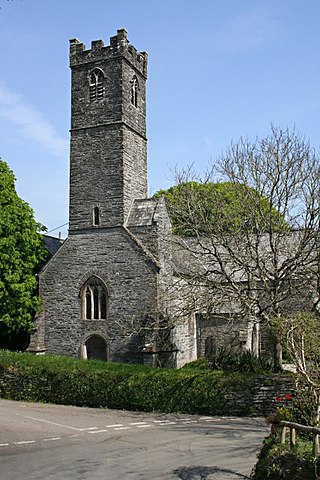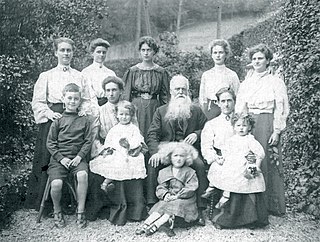
St Clement Danes is an Anglican church in the City of Westminster, London. It is situated outside the Royal Courts of Justice on the Strand. Although the first church on the site was reputedly founded in the 9th century by the Danes, the current building was completed in 1682 by Sir Christopher Wren. Wren's building was gutted during the Blitz and not restored until 1958, when it was adapted to its current function as the central church of the Royal Air Force.

The Diocese of Truro is a Church of England diocese in the Province of Canterbury which covers Cornwall, the Isles of Scilly and a small part of Devon. The bishop's seat is at Truro Cathedral.

Quethiock is a village and civil parish in Cornwall, England, United Kingdom, roughly five miles east of Liskeard. According to the 2001 census the parish had a population of 429, increasing to 443 at the 2011 census. The ancient parish church of St Hugh is one of the most notable in Cornwall. The placename derives from the Old Cornish cuidoc meaning wooded place. In 1871 the population was 661 and the area 4,351 acres (17.61 km2).

Doncaster Minster, formally the Minster and Parish Church of St George, is the Anglican minster church of Doncaster, South Yorkshire, England. It is a grade I listed building and was designed by architect designer George Gilbert Scott. The church was built in 1854–1858 to replace an earlier building destroyed by fire. It is an active place of worship and has a Schulze organ, a ring of eight bells, and a celebrated clock by Dent. The church is one of two parish churches to have minster status in South Yorkshire. The other is the minster church of Rotherham.

Grade–Ruan is a civil parish on the Lizard peninsula in Cornwall, England, United Kingdom, approximately ten miles (16 km) south of Falmouth.
The Bishop of St Germans is an episcopal title which was used by Anglo Saxon Bishops of Cornwall and currently in use in the Church of England and in the Roman Catholic Church.

The Church of King Charles the Martyr is a parish church in the Church of England situated in the centre of Falmouth, Cornwall.

St Bartholomew's Church, Armley is a parish church in the Church of England in Armley, West Yorkshire. The church is one of two Church of England churches in Armley; the other being Christ Church. Worship at St Bartholomew's is firmly rooted in the Anglo-Catholic tradition of the Church of England with a solemn mass being celebrated weekly.

St George the Martyr's Church, Truro is a Grade II listed parish church in the Church of England in Truro, Cornwall.

St Paul's Church, Truro is a Grade II listed former parish church in the Church of England Diocese of Truro and in Truro, Cornwall.

St Ildierna's Church, Lansallos is a Grade I listed parish church in the Church of England in Lansallos, Cornwall, built in the early 14th Century. The church is noted for its 16th Century benches and bench ends. Serious damage was caused to the church, especially the roof, by a fire in 2005.

St Mary Magdalene's Church, Launceston is a Grade I listed parish church in the Church of England in Launceston, Cornwall. It is unusual for its carvings; the entire exterior of the original part of the church is built of carved granite blocks. The church is dedicated to Jesus' companion, Mary Magdalene.

St Gwinear's Church, Gwinear is a Grade I listed church in the Church of England in Gwinear, Cornwall.

St Gothian's Church, Gwithian is a Grade II* listed parish church in the Church of England Diocese of Truro in Gwithian, Cornwall, England, UK. Nothing is known about St Gothian, Gocianus or Gwithian.
William Robert Stuart-White is a British Anglican priest. He was Archdeacon of Cornwall from 2012 until 15 May 2018, when he was installed rector of All Saints', Falmouth.
Hugh Edmund Nelson is a British Anglican bishop and former charity worker. Since July 2020 he has served as Bishop of St Germans, the suffragan bishop of the Diocese of Truro.
St Mary the Virgin Church is a parish church in Welling in the London Borough of Bexley. It is dedicated to the Virgin Mary. The church is in the Archdeaconry of Lewisham & Greenwich, in the Diocese of Southwark. It is notable for the range of 20th-century art contained within it.
St Mary and All Saints Church is the parish church of Little Walsingham in the English county of Norfolk. It is dedicated to the Virgin Mary and All Saints. Little Walsingham was the location of the shrine of Our Lady of Walsingham, destroyed at the Dissolution. The Anglican shrine was revived by Alfred Hope Patten, the Vicar of Little Walsingham, in 1922, and the image of Our Lady of Walsingham was in the church until its translation to the new priory in 1931.

St Anne's Church is a parish church in the village of Hessenford in Cornwall. It is dedicated to St Anne, the mother of the Virgin Mary. The church is in the Archdeaconry of Bodmin, in the Diocese of Truro. The church is largely the work of J P St Aubyn, and is Grade II listed.

The Pinwill sisters were British professional woodcarvers in Devon from 1890 onwards. Although in their era there were women who produced stained glass, sculpture, wood and metalwork for churches, those women were largely unacclaimed and regarded as amateurs. The profession of ecclesiastical wood carving was one entirely carried out by men. The sisters not only became skilled at the craft, but also set up a professional workshop business. Despite the challenges of two world wars, two fires and the departure of two of the sisters, the Pinwill workshop produced innovative ecclesiastical carvings in wood and stone for more than 60 years and for over 180 churches in Devon, and Cornwall and further afield, becoming one of the most successful wood carving businesses in the South-West of England. Their vast body of work, gradually adapting from the complex, intricate designs of the Gothic Revival through to the pared-down, plainer style of twentieth-century Modern, is recognised as being of great skill, flair and worth.
















